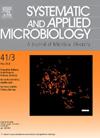来自蜥蜴的卡帕多慈氏螺旋杆菌新种(Helicobacter cappadocius sp:第一个精神滋养型螺旋杆菌物种
IF 4.2
2区 生物学
Q2 BIOTECHNOLOGY & APPLIED MICROBIOLOGY
引用次数: 0
摘要
该研究旨在确定图尔基耶一些爬行动物和两栖动物中螺旋杆菌的流行情况,并对这些细菌进行描述。为此,研究人员使用了 73 份泄殖腔拭子样本作为材料。通过详细的表型测试、全基因组分析和 MALDI-TOF MS 对分离菌进行了描述。表型分析的结果是,发现了两种螺旋形、弯曲的革兰氏阴性、能动的分离物。通过分析 16S rRNA 基因序列,确定这两个分离物属于螺旋杆菌属。这些分离物被发现与其他螺旋杆菌属属不同。不过,16S rRNA 序列与任何已确定的物种都不匹配,最接近的匹配是芥子螺旋杆菌菌株 R85-13-6T,其同一性水平为 96.2%。此外,研究还发现 faydin-H75T 和 faydin-H76 菌株的 16S rRNA 基因具有 99.3 % 的同一性。在进行 dDDH 和 ANI 分析后,发现 faydin-H75T 菌株与近邻 H.anseris ATCC BAA-1299T 菌株的相似度分别为 13.5 % 和 68.8 %。菌株的基因组大小为 1.7 Mb,G + C 含量为 33.5%。利用 IMNGS 和 Protologger 工具进行的元基因组分析表明,faydin-H75T 在多种蜥蜴物种中都存在,且相似度很高,这证实了它的广泛分布和宿主特异性。结果表明,这两株菌株代表了一个新物种,我们建议将其命名为卡帕多西螺旋杆菌,并以 faydin-H75T (=NCTC014972 = LMG 33382 = DSM117062)作为各自的模式菌株。当前的新物种是第一个表现出精神营养特征的螺旋杆菌物种。本文章由计算机程序翻译,如有差异,请以英文原文为准。
Helicobacter cappadocius sp. nov., from lizards: The first psychrotrophic Helicobacter species
It was aimed to determine the prevalence of Helicobacter in some reptilian and amphibian species in Türkiye and to describe the bacteria. For this purpose, 73 cloacal swab samples were used as material. The description of the isolates was performed by detailed phenotypic tests, whole genome analyses, and MALDI-TOF MS. As a result of the phenotypic analysis, two helical, curved Gram-negative, motile isolates were recovered. It was determined through the analysis of 16S rRNA gene sequences that two isolates belonged to the genus Helicobacter. These isolates were found to be in a distinct group from other Helicobacter species. However, the 16S rRNA sequence did not match any identified species, with the closest match being Helicobacter mustelae strain R85-13-6T, which had an identity level of 96.2 %. Additionally, it was found that strains faydin-H75T and faydin-H76 had a 99.3 % identity level for their 16S rRNA genes. After conducting dDDH and ANI analyses, it was found that strains faydin-H75T and their close neighbors H.anseris ATCC BAA-1299T shared 13.5 % and 68.8 % similarity, respectively. The genome size of the strains was 1.7 Mb while G + C contents were 33.5 %. Metagenomic analyses using IMNGS and Protologger tools revealed the presence of faydin-H75T in various lizard species with high similarity, confirming its broad distribution and host specificity. The results indicated that these two strains represent a novel species, for which we propose the name Helicobacter cappadocius with faydin-H75T (=NCTC014972 = LMG 33382 = DSM117062) as the respective type strain. The current novel species is the first Helicobacter species to exhibit a psychrotrophic feature.
求助全文
通过发布文献求助,成功后即可免费获取论文全文。
去求助
来源期刊

Systematic and applied microbiology
生物-生物工程与应用微生物
CiteScore
7.50
自引率
5.90%
发文量
57
审稿时长
22 days
期刊介绍:
Systematic and Applied Microbiology deals with various aspects of microbial diversity and systematics of prokaryotes. It focuses on Bacteria and Archaea; eukaryotic microorganisms will only be considered in rare cases. The journal perceives a broad understanding of microbial diversity and encourages the submission of manuscripts from the following branches of microbiology:
 求助内容:
求助内容: 应助结果提醒方式:
应助结果提醒方式:


